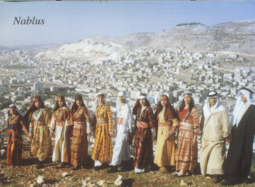Dabke
Dabke (Arabic: دبكة also spelled dabka, dabki, dubki, dabkeh, plural dabkaat)[1] is a Levantine folk dance,[2][3] particularly popular among Lebanese, Jordanian, Palestinian, and Syrian communities.
[7] According to Youssef Ibrahim Yazbec, a Lebanese historian, journalist, and politician,[9] the dabke descends from Phoenician dances thousands of years old.
[10] According to Palestinian folklorists Abdul-Latif Barghouthi and Awwad Sa'ud al-'Awwad, the dabke jumps may have originated in ancient Canaanite fertility rituals related to agriculture, chasing off evil spirits and protecting young plants.
[citation needed] The Oud (عود), from which the English word "lute" comes, is shaped like half a pear with a short non-fretted neck.
It is a type of reed clarinet that is played by breathing smoothly through a circular aperture at the end and by moving the fingers over the holes down the front of the tube in order to create the different notes.
Most tablahs are beautifully decorated, some with wood, tile or bone inlay, etched metal, or paintings in designs typical of the Near East.
One of the most commonly played of the percussion instruments; the tablah is a membranophone of goat or fish skin stretched over a vase-shaped drum with a wide neck.
In the 20th century and beyond, dabke has both been interpreted as an element of nationalist ideologies or as a modern and aesthetic form of folk dance, performed by academically trained dancers from the Higher Institute of Dramatic Arts.
To reinforce these interpretations and the continuation of dabke in rural as well as in urban settings, performances have been promoted countrywide by government-sponsored folk dance ensembles as well as in educational programs disseminated by the Ministry of Culture.
Since the beginning of the Syrian Civil War, dabke performances as a manifestation of community gatherings have further accompanied protest meetings and demonstrations against the ruling government of Syria.


